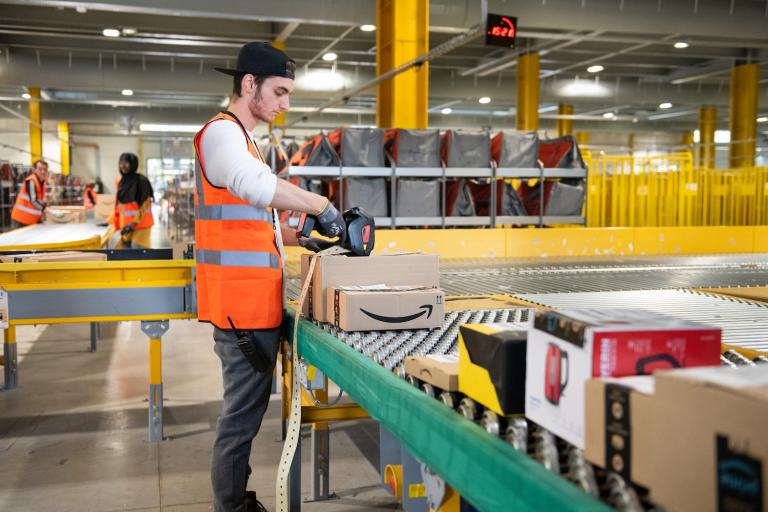Local retailers and grocers need Amazon-style automation. Here’s how it can work.

Accelerated by the coronavirus, micro-fulfillment is reshaping retail and giving customers more options for same-day delivery.
Even before the global pandemic, it was clear that small retail and grocery had a distribution problem. With Amazon setting the standard for next-day and even same-day delivery, other retailers have struggled to keep up.
The “Amazon effect" has other businesses scrambling to match Amazon's online ordering system, often relying on in-store pickup to get products to customers. Still, nothing matches the convenience, and these days, safety, of ultra-fast delivery of the kind that few but Amazon, with its purpose-built network of distribution hubs, provides. And during a pandemic, solving the problem of same-day delivery for everyone else is now more vital than ever.
Democratizing same-day delivery
Following a severe back injury in his native U.K. in the mid-2000s, the same-day delivery problem was one that Ohi founder and CEO Ben Jones experienced more keenly than most. The injury left him disabled during a 60-month recovery period. “I was very restricted," he says now. “I couldn't walk very far. I couldn't carry anything. Shops were completely off-limits, and I had to rely on e-commerce."
His biggest frustration, however, even greater than his limited mobility, was an inability to get prompt delivery from anywhere but Amazon. “I thought, this is absurd," he says. “Why can Amazon do this so well, and no one else can?" Thus, it engendered his mission to democratize same-day delivery. It's a quest that retailers everywhere need to adopt now, more than ever, to keep serving their customers.
That's because, with the global lockdown imposed by authorities in effort to stem the tide of COVID-19 infections, millions of people, with or without disabilities, find themselves in Jones' shoes. The problem is compounded by Amazon itself dialing back on deliveries of what it deems non-essential items, further restricting the goods that customers can get quickly.
Spurred by the coronavirus crisis, however, retailers are catching up, thanks to technologies provided companies like Ohi.
Micro-fulfillment fills the gap
At an Albertsons supermarket in San Francisco, orders stream through an online system like those used by retailers around the world. However, here, instead of sending the orders to employees to hand-pick vegetables and other items from the store's shelves, the system instead sends them to a robotic picking system in an attached micro-fulfillment center. The company that built the center for Albertsons, Takeoff Technologies, says the center can pick 60 items in just five minutes.
For chains with relatively deep pockets, such fulfillment centers could be the answer to Amazon's acquisition of Whole Foods and subsequent reach into neighborhood grocery stores in 2017. Takeoff plans to expand from five grocery micro-fulfillment centers at the start of 2020 to 50.
But multi-million dollar setups like that are out of reach of smaller retailers and take months to build out. That's why Jones sees a driving need for the kind of micro-fulfillment services Ohi provides. Ohi, which launched in March 2019 in New York, saw the volume of products it handles increase tenfold from February to April 2020. It now serves consumers in Manhattan, Brooklyn, San Diego, Los Angeles, and San Francisco with orders for shoe, beauty, and beverage brands, among others.
To start fulfilling orders quickly, Ohi rents under-utilized spaces in urban centers and transforms them into small-scale distribution centers. One of Ohi's distribution centers in New York City, for example, occupies formerly unused floor space in an office building Manhattan's garment district.
In contrast to the highly automated solutions of purpose-built distribution centers, including those of Amazon, Ohi employees pick and pack the orders manually. Jones says that keeps setup costs low—in the neighborhood of $10,000 for a micro-fulfillment center shared by multiple retailers. “Simplicity wins," Jones says.
Location is key
What Jones calls Ohi's secret sauce is data analytics software that calculates the right amount of each product to stock for each of its retail customers in each micro-distribution center. The numbers are based on previous sales and projected demand for a roughly seven-mile radius around a fulfillment center, and they're continually updated.
“It's constantly, dynamically rebalancing the system to make sure that, as we seek spikes in demand, we can push orders to the right warehouses," Jones says of the proprietary system. The company and its customers rely on local delivery services and couriers to handle the last mile of deliveries to customers' homes and businesses.
Jones sees nimble micro-fulfillment as the future of retail, even after the outbreak crests—a future that will see cities significantly changed. “There's so much space within cities that's used for physical retail that just won't be needed anymore," Jones says. “You'll end up with cities changing a lot as those locations become empty, and people start thinking of ways to use them differently."
Add it to the list of ways that the pandemic could alter cities in its aftermath.
Have your say
Sign up for our newsletter
Why sign up:
- Latest offers and discounts
- Tailored content delivered weekly
- Exclusive events
- One click to unsubscribe